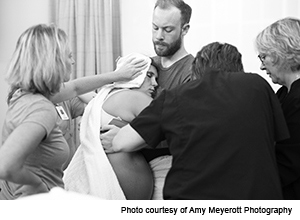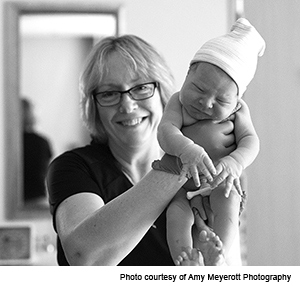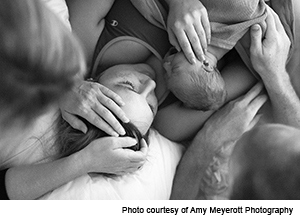Mercy's is one of a handful of U.S. centers located in a hospital
By JULIE MINDA
To satisfy the preferences of expectant mothers who want a natural, low-intervention birth — but who also want the safety net of a full-service hospital should any complications arise Mercy Hospital St. Louis has opened the $2 million, four-suite Mercy Birthing Center, one of the few birthing centers in the U.S. located within a hospital.

Susan Ray and her husband Sean Ray are surrounded during their son's birth, by doula Christa Stauder, at left, a nurse and certified nurse midwife Diana Buckwalter, at far right.
The facility offers prenatal care and education, labor and delivery and postpartum care with a low level of medical intervention for women with low-risk pregnancies. Certified nurse midwives employed by Mercy provide the care, instead of obstetricians, as is the norm in hospital labor and delivery units.
Diana Buckwalter, program director of the birthing center, said she and Elizabeth Cook, the center's other nurse midwife, treat birth as a natural process. The center's service model calls for ample patient nurturing and limited technological monitoring. Normally, a handheld Doppler device is the only technology used during active labor at the birthing center. Laboring patients do not wear the electronic fetal heart rate monitoring device commonly used in hospital births. The birth center does not offer epidural anesthesia, labor induction or instrument-assisted deliveries.
Buckwalter said she or Cook attend to patients during the births; some patients employ their own doula or birth coach too.
Focus feedback
Mercy Hospital St. Louis delivers more babies than any other hospital in the St. Louis region. There were 8,347 births there in 2013. Buckwalter has been building relationships with Mercy's obstetricians and gynecologists and teaching them about midwifery practice. She said that has created an atmosphere of acceptance among other clinicians for the birthing clinic and its techniques.
Trish Geldbach is vice president of women's services for Mercy Hospital St. Louis and its parent, Chesterfield, Mo.-based Mercy. She said Mercy leaders began planning the birthing center in response to input several years ago from women participating in focus groups for a renovation of Mercy Hospital St. Louis' labor and birth department. The majority in the focus groups said they wanted homelike features in a birth environment. A few of the women also expressed the desire for an unmedicated, low-intervention, low-tech birth.
The hospital completed its $27 million project with 31 labor and birth suites in January 2013. The new wing incorporated niceties common in newer labor and delivery wards, including whirlpool tubs, flat-screen TVs and relaxing colors and lighting. The hospital left shelled space during that construction for what would become the Mercy Birthing Center to address the preferences of women wanting low-intervention birthing options.
Home birth alternative
The Mercy Birthing Center expects to draw many of its clients from the small population of women who would prefer a home birth, but who are concerned about the risks associated with home births, said Geldbach.

Buckwalter presents newborn Theodore "Theo" James Ray.
According to the American College of Obstetricians and Gynecologists' Committee on Obstetrical Practice, "planned home birth is associated with a twofold to threefold increased risk of neonatal death when compared with planned hospital birth."
Nevertheless, a January 2012 report from the Centers for Disease Control and Prevention's National Center for Health Statistics said U.S. home births rose to 0.72 percent in 2009 from 0.56 percent in 2004. The 10 years before 2004 the rate had been declining. The report said home births were more common among women aged 35 and over, and among women who had previously had children. A 2010 report from the National Center for Health Statistics' National Vital Statistics System said non-Hispanic, white women and married women were more likely than other populations to give birth at home or at a freestanding birth center.
Karen Rhoades is clinical coordinator for family education and solace at Lutheran Medical Center in Wheat Ridge, Colo., part of Denver-based SCL Health. Lutheran does not have a dedicated center for natural births as part of its obstetrics services. Rhoades said that while the slight uptick in home births nationally does not represent a threat to hospitals' labor and delivery business, it behooves hospitals to understand why the increase may be happening. She said the most common reasons women cite for wanting home births is that, in addition to the comforts of home, they want their wishes for their birthing experience to be respected and honored.
Mercy's model
The American Association of Birth Centers — Mercy is a member of the association — says there were 255 birth centers in the U.S. in 2013, up from 125 in 1984. The vast majority are freestanding. In fact, according to information Mercy received from the birth center association, there are only three or four birth centers in the nation located within a hospital.
Mercy's birthing center is on the ground floor of the hospital, and its obstetrics surgery suite and traditional labor and birth suites are in the same tower. The center's location inside the hospital allows for rapid intervention should unexpected complications arise during delivery. The neonatal intensive care unit is an elevator ride away.

Susan Ray and Theo receive soothing touch.
Geldbach said the birthing center has an obstetrician as its medical director and it collaborates with four Mercy physicians who take over care if higher intensity medical or surgical intervention is warranted.
Mothers scheduled to give birth at the birthing center will be admitted to the hospital's labor and birth suites instead if they go into labor before 37 weeks' gestation or after 42 weeks, if labor must be induced or augmented with drugs, or if the patient decides to receive an epidural.
Buckwalter said that just like with women who plan to deliver in a hospital, the birthing clinic's prenatal patients get regular check-ups and they typically undergo ultrasound tests. They prepare for labor and delivery the same as patients who opt for hospital deliveries. Newborn babies at the birthing clinic undergo the same testing, monitoring and postnatal care as healthy hospital-born babies. All of the prenatal care is delivered in the birthing center, and midwives and patients get to know each other through a great deal of one-on-one contact. That continuity of contact allows patients to build trusting relationships with the midwives and staff and develop a familiarity with the facility that can contribute to their sense of comfort during their labor and delivery, said Buckwalter.
Bouncing baby boy
Susan Ray, 26 of St. Louis, was the first to deliver at the Mercy Birthing Center. She welcomed her first child, Theodore "Theo" James Ray, on Sept. 1.
She originally had planned to deliver at Mercy Hospital St. Louis' labor and birth suites, but her prenatal yoga instructor told her about the new birthing center and Ray decided to deliver there instead.
"When I heard about it, I liked their mission of having no intervention until necessary," she said, noting that, for her, the birth center provided a welcome balance between a home and a hospital birth.
During the delivery her doula birthing coach and Buckwalter helped her with techniques so that the birth — while painful — went smoothly. And Ray said she cuddled with her son and husband in the queen-sized bed and listened to the bubbling from the wall-mounted fountain in her room.
Of the birthing center, she said, "It's an amazing place where people really care about you and make you feel special and are really encouraging."
Center welcomes low-risk moms St. Louis' Mercy Birthing Center is available to expectant moms of any age who, among other qualifications: - Have no complex medical conditions
- Are carrying a single baby
- Have a baby positioned head down
- Go into labor between 37 and 42 weeks of pregnancy
- Have had no prenatal tests indicating a need for electronic fetal monitoring
- Have not had a prior caesarian section
|
Copyright © 2014 by the Catholic Health Association
of the United States
For reprint permission, contact Betty Crosby
or call (314) 253-3477.